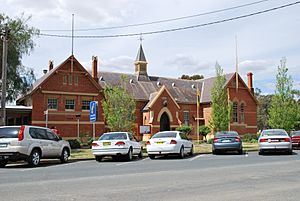Deniliquin Public School and School Master's Residence facts for kids
Quick facts for kids Deniliquin Public School and School Masters Residence |
|
|---|---|
 |
|
| Location | George Street, Deniliquin, Edward River Council, New South Wales, Australia |
| Owner | Deniliquin Council |
| Official name: Public School & School Masters Residence (former); Peppin Heritage Centre | |
| Type | state heritage (built) |
| Designated | 2 April 1999 |
| Reference no. | 144 |
| Type | School – State (public) |
| Category | Education |
| Lua error in Module:Location_map at line 420: attempt to index field 'wikibase' (a nil value). | |
The Deniliquin Public School and School Masters Residence is a very old and important building in Deniliquin, New South Wales, Australia. It used to be a school where children learned for many years. Today, it is known as the Peppin Heritage Centre.
This special place now works as a museum, an arts centre, and a visitor information centre. It is located on George Street and is owned by the Edward River Council. Because of its history, it was added to the New South Wales State Heritage Register on April 2, 1999.
Contents
A Look Back at Deniliquin School
The story of this building goes back a long time. It shows how education grew in the Deniliquin area.
Early Days: Building a School
In 1857, people chose a spot for a new school. It was near the Edward River. By 1861, a brick schoolhouse was built there. It faced George Street.
At that time, many children in the area did not go to school. A study found that only 138 out of 613 children attended classes.
New Buildings and Changes
As more children needed to learn, the school grew. In 1879, a brand new school building was constructed on the same site. For one year, the old 1861 school building became the home for the school principal, called the schoolmaster's residence.
However, the old building was in poor condition. The principal, David Kennedy, did not want to live there. So, in 1880, the old building was taken down. A new and much better schoolmaster's residence was built. It was designed in a style called Gothic Revival.
Over the years, the school kept getting bigger. In 1899, more space was added to the school. Then, in 1905, another room was built. Even more classrooms and a science room were added in 1928. This shows how important the school was to the community.
From School to Heritage Centre
The Deniliquin Public School served its community for many decades. It finally closed its doors as a school in 1972. After that, the Deniliquin Municipal Council took over the building.
They decided to turn it into something new and useful for everyone. It became a museum and an arts centre. A group called the Museum Trust and the George Street Historical Society helped manage it. Today, it continues to be a place where people can learn about history and enjoy art.
Why It's Special: Heritage Status
The Public School and School Masters Residence is very important. It was officially listed on the New South Wales State Heritage Register on April 2, 1999.
Being "heritage-listed" means that a place has special historical value. It is protected so that future generations can also learn from and enjoy it. This building helps us remember the history of education in Deniliquin.

